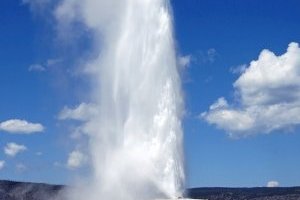
In 1806 when the Lewis and Clark expedition returned through what is now the state of Montana, one of its members broke off early to continue exploring, and encountered what he described as a hellscape, a place of "fire and brimstone" that is now known as Yellowstone National Park. His descriptions inspired more expeditions to survey this land of geothermal activity, where mud boiled, hot water erupted in geysers, and travertine terraces grew on hillsides. In turn, explorers and early environmentalists campaigned to the US government to purchase the land around Yellowstone, creating a national park for the "benefit and enjoyment of the people". In 1872, Yellowstone became the first national park in the United States, and arguably, the world. Almost a century later, it became one of two US sites in the inaugural World Heritage Site cohort in 1978.
I visited Yellowstone for the first time five years ago, in late summer 2015. Summer is very busy at Yellowstone, and lodging can sometimes be challenging, so a friend of mine and I ended up camping in two of the several campgrounds available throughout the park and eating at the many restaurants found in hotels and villages throughout the park. The Sturgis Motorcycle Rally in South Dakota had just finished the week before, and summer vacations were finishing up, so there were a lot of fellow visitors. Still, the park was large enough that it didn't feel too crowded once getting away from premier tourist sites such as Old Faithful geyser, which was as fun to watch as I'd read about growing up.
For folks visiting Yellowstone, the two premier aspects of the park to focus on are the geology and the wildlife. For geology, the trails around geyser fields and hot water pools, to include the Grand Prismatic Spring, are worth exploring. I also appreciated hiking around the travertine terraces of Mammoth Hot Springs, near the old Fort Yellowstone. The hike at the Grand Canyon of the Yellowstone showed off colorful hillsides and a beautiful waterfall, although the faint sulfur smells of the geothermal zone was still present there. Just outside the northern entrance to the park in Montana, which includes a stone arch dedicated by US President Theodore Roosevelt, is an opportunity to swim in the "Boiling River", where a thermal river feeds into the Gardner River.
As impressive as the geology is in the park, I don't find the park as naturally beautiful as the national park to the south in Wyoming -- the Grand Tetons, which is absolutely worth a visit. Both parks share wildlife, however, and I was able to see bears from a safe distance (there is a reason bear spray is sold in stores), as well as the ubiquitous bison that amble around the park roads. Care must be taken with the bison, since every year there are reports of bison attacks because they have been provoked. The animals I had hoped to see but did not encounter, despite spending an afternoon driving around the Lamar Valley in the northeastern portion of the park, were the grey wolves which had been reintroduced to Yellowstone twenty years earlier in 1995.
For historians or architecture lovers, I must recommend stopping by some historic buildings at Yellowstone, to include the massive wooden Old Faithful Inn, the rather southern style Lake Hotel, and the historic Fort Yellowstone. For World Heritage Site plaque hunters, the plaque can be found on the lower level of the Albright Visitor Center, part of the fort complex. Yellowstone may not be the most beautiful park I have seen in the US, but it is absolutely worth the detour to visit.
Logistics: The easiest way to get to and around Yellowstone is via private transporation. Be aware that some passes on roads entering the park may be closed during the winter and spring due to weather.
More on
Comments
No comments yet.
